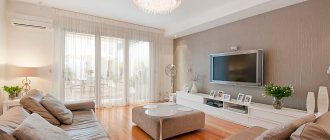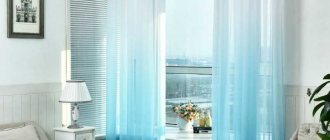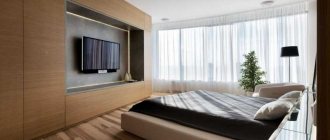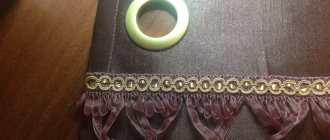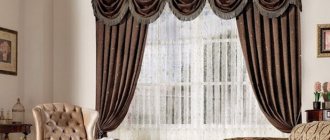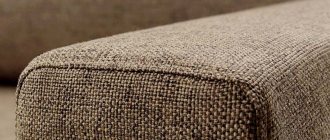Window decoration is something that any design project cannot do without. To design them, stylists use a variety of combinations. Fashion sets new trends, and unusual combinations of styles are acceptable in trends.
Light textiles give the living room interior a special atmosphere and make it complete. Most often, curtains and tulle are hung on cornices.
It is precisely thin transparent curtains that have started to play in new ways today in different directions.
In fashion publications you can see many ways to hang tulle without curtains. Designers offer their ideas, which they implement according to the examples shown in the photo.
At the same time, stylists give advice on how to choose tulle for the hall. Colors, textures, patterns and fabrics must be combined. Window stylization is a decisive accent that brings special harmony to the space.
Airy tulle in the interior looks especially beautiful and aesthetically pleasing. Such a detail can completely change the overall mood and set the dynamics in the interior.
Heavy and multi-layer curtains are becoming a thing of the past, their place is taken by airy tulles.
Interesting variations of tulle for the hall
Curtains are starting to slowly disappear from room design. In their place comes tulle - transparent or translucent. The unfolded tulle completely illuminates the room with sunlight. And the closed tulle also lets the sun in, but does not allow you to see what is happening in the apartment from the street. In a word, tulle for a hall without curtains is gradually becoming more and more popular solution among designers.
Unusual solutions
Modern fashion trends allow the use of tulle in black, dark brown, and bright red tones. This is not forbidden when the room is spacious and the windows are quite large. A black curtain in a small living room is inappropriate because it will visually make the room even smaller.
Net
In most cases it is made from synthetic fiber. The result is beautiful, sophisticated and unusual highlights. This look is often done on organza.
Non-standard windows
If you need to emphasize the original or unusual shape of the window, then in this case you can also safely use tulle.
With balcony door
The design of the curtains should match the doors and not interfere with their functioning.
The photo shows a room with a balcony door decorated with tulle.
Arch
This form of window opening is itself a decorative element; to enhance this effect, it is worth using tulle compositions for decoration. It is not recommended to use massive structures.
Bay window
When choosing curtains for a bay window, it is better to use not very dense fabric in pastel shades to add spatial depth to the room.
The photo shows a classic-style hall with a bay window and light curtains.
Corner window
In order to give such windows a special sophistication and emphasize grace, you can choose a translucent, weightless fabric in light colors.
For two windows
Two window openings with a partition or a room where the living room is combined with a kitchen can also be decorated with tulle, in which case unnecessary workload can be avoided.
Tulle made from linen
This fabric looks sparse, like a worn mesh, and the room looks very cozy and beautiful. An important note is that there are obvious parts of the threads on linen; they diverge in thickness - this makes the fabric more voluminous. And the volume, in turn, gives the fabric fluffiness and warmth.
Linen fabric has a special weave, thanks to which it is laid out in large folds. Tulle made from this fabric fits best into the Provence style.
Tulle sizes
The choice of length is one of the main components when decorating a window opening, which will allow you to change the shape and size of the room.
Short
An original way to decorate a small space. The length to the window sill is suitable for a room in a classic, country or Provence style.
Long
The most popular length option, it looks elegant, visually enlarges the ceiling and the living room space as a whole.
Additions to tulle design
If you decide that tulle and curtains for the hall are not for your home, then there are several more ways to enhance the attractiveness of a room with curtains.
Crossing a pair of curtains
On one cornice it is worth hanging two tulles one after another. Tie each one to curtains located oppositely.
Fabric shine
This is achieved with the help of certain threads built into the fiber, creating the impression of a spark, shimmering glare. This effect occurs due to sunlight hitting the fabric.
Note!
Curtains for windows - TOP 120 photo and video examples. Styles and shapes of curtains, their differences. Advantages and disadvantages of window curtainsTulle in the interior: types of tulle, pros and cons of the material. Selection of colors, lengths, quantities and patterns of tulle for different interiors (photo + video)
DIY curtains - instructions for sewing curtains with your own hands. Types of fabrics, colors and patterns for curtains. 120 photos + video reviews
Shining tulle looks very beautiful in a large and bright room, because it brings the window and walls closer together. Without sunlight, with artificial lighting, the flickering effect does not disappear, but only becomes brighter, and in daylight it darkens.
Exquisite curtain, not framed by curtains
Such options are welcome when the room is small and its windows should not be overloaded with additional drapery. In this case, a denser tulle is purchased. In addition, the curtains can be of more saturated shades.
Depending on the interior style, you should choose dark brown, beige, or noble gray tones. Tulle with a pattern looks great without curtains. Floral motifs, or landscapes or night views of the city printed on fabric are beautiful.
When does tulle look best?
Transparent tulle without bulky curtains and curtains looks more than beautiful in the following options:
Small room. Flowy fabrics are great for small spaces because they make the room seem larger. This happens by filling the hall with sunlight. Unlike curtains, which create a clear boundary between the wall and the window, tulle erases these boundaries.
Rooms with little light are usually located on the west, north and north-west sides. These rooms always look very cool; to “warm” them, it is best to hang tulle with the same color scheme.
Certain trends in design: oriental, Provence, minimalistic. Rooms designed in this style should always be illuminated with natural light. In this case, tulle gives the room lightness, grace and sophistication.
Note!
- Photos of curtains: design of curtains of different sizes and lengths. Color range, types of materials, patterns and curtain fastenings (photo + video)
- Organza tulle: advantages and disadvantages of the material. Varieties of tulle and fastenings. Tips for sewing and installation (photo + video)
- Tulle design - TOP 130 photos + video reviews of tulle designs. Features of choosing fabric, length, quantity and type of tulle
Large rooms in a bulky classic style. Here it is immediately clear that translucent tulle will add sophistication and elegance.
The presence of floor-to-ceiling windows in the room. With such windows you can admire the views from the windows. Tulle will look very advantageous against such a background, creating a shimmering effect. It will look especially beautiful if the room has a balcony.
Color spectrum
The shade of tulle directly depends on the design of the room; you can choose plain, bright, with transitions, or combined.
One thing worth considering is that they must match the color of the thick curtains.
The most popular options:
- White;
- Grey;
- Light yellow;
- Turquoise;
- Light pink;
- Light green;
- Lilac;
- Amethyst;
- Fuchsia color;
- Bronze;
- Pearl;
- Light green;
- Light orange;
- Gray;
- Red-beige.
How to effectively hang tulle
To create a beautiful room using an element such as tulle, there are several popular ideas from designers:
Transparent tulle is hung directly on the rings, the loops are straight - the fabric should develop from floor to ceiling without folds. This is the most versatile option, best used in a minimalist style.
Another great option would be to buy enough fabric at once so that when you hang it, the tulle folds into exquisite folds, resulting in a kind of multi-layered product. It’s easy to guess that such options are suitable for large, bright rooms.
Combination of several colors of fabric on one window. There is a huge range of design options: a transition from dark to light colors, a combination of shades that are completely different from each other.
Note!
Gray tulle: nuances of using gray tulle in the interior. Suitable gray fabric materials. 150 photos + video examples- Tulle on a ribbon: advantages and disadvantages of tulle on a ribbon. Types of curtain tapes. Tips for sewing and installation (photo + video)
- Small curtains: TOP-180 photos + video of design options for small curtains. Features of small curtains in the interior. Types of curtains, fabrics and colors
But it is very important to seize the moment so that at least one color is combined with the shades of the interior of the room, this will make the interior as harmonious as possible in terms of color relationships.
Combination of different lengths of fabrics. The room will look very impressive if you add long tulle to the floor and hang shorter tulle on top. The resulting layering will look very lush.
Combining fabric textures. An interesting option would be to mix smooth and light fabrics with rough ones, plain tulle and bright embroidery, exquisite lace and light silk.
For a classic style, such a decoration option as cords for picking up tulle is suitable.
You can try using lambrequins. This creates the effect of sophistication and luxury. But in order not to overdo it and not to make it cheaply, the ideal option would be to make lambrequins from a plain, smooth fabric.
Draping methods
It is worth trying to create waves of equal width. They are easy to obtain using special garters or ribbons. Often the curtain can be assembled accordingly by hand.
This is easier to do when the fabric is thicker. This one can be washed as many times as you like, and you don’t have to worry about additional drapery in the form of roller curtains or blinds.
Photo of tulle in the hall
Combining tulle
Having good taste, you can easily give the window an authentic look using various combinations.
Roman curtains
In this tandem, tulle is designed to smooth out the small imperfections inherent in Roman blinds.
Roller blinds
While roller blinds protect from light, tulle curtains in this combination perfectly perform a decorative function.
curtain
This set will always be relevant at all times. Thanks to this combination, a feeling of complete harmony is created in the room.
The photo shows a room with a combination of curtains and tulle.
Blinds
In order to remove excessive formality in the living room, it is recommended to frame the blinds with light tulle.
The photo shows a room with windows, where light curtains and blinds are successfully combined.
Lambrequin
The tulle should complement the lambrequin, creating a single whole with it. It is important that the colors and textures match. One of the most worthy decoration options in the hall.
With pick-up
The catch is used not only as a regular fastening. It can also become an indispensable accessory for a real masterpiece in the design of a window opening.
Additional fashion elements
If you are interested in fashionable tulle for a room without curtains, then keep in mind that you can enhance the visual appeal of translucent and transparent fabrics on windows using the following techniques:
Fabric shimmer effect
It is achieved through the inclusion of special threads in the fiber structure, which create a beautiful effect of star rain, small sparks, and fireworks. The light bounces off them, resulting in a beautiful shimmering shimmer. This type of tulle is especially suitable for a large hall. Because it visually brings the wall with the window closer. Under artificial lighting, the flickering effect intensifies. During the daytime it becomes more muted.
Beautiful drapery with a weighting effect
In this case, the length of the tulle is increased by 20-30 cm. When hanging the curtains, their lower edge lies on the floor in rich folds. This effect looks especially beautiful if there is a curly cut along the bottom. If it is not there, then when performing roll overcasting of the fabric, you can include a bottom-weighting braid in it.
Choosing a cornice
Before hanging the tulle on the window, you need to choose a cornice.
The determining factor is the textile composition:
- Tulle without curtains. In this case, a string or rod cornice is used. The first option is a steel wire stretched between the brackets. It is suitable for light and thin products. The design is simple and durable. Over time, the metal succumbs to corrosion. A rod cornice is a metal or plastic pipe with rings.
- Tulle and curtains. You can hang them on a rod, baguette or profile cornice. The first option is classic, corner, arched, sliding. Profile (rail) - flat products with tracks inside. Its design often includes a rotating mechanism.
- Tulle on lambrequins. For such compositions, a triple modified profile cornice is used.
For expensive interiors, designer cornices are used.
Material selection
Modern tulle is made from a variety of fabrics, but most often these are synthetic materials. Let's take a closer look at the pros and cons of each fabric.
Veil:
- soft, smooth and delicate to the touch;
- denser than organza and softer;
- offers many color options;
- better protection from the sun.
However, the veil also has significant disadvantages - for example, it gets dirty much faster and is much worse to clean. It deteriorates in the sun and is quite subject to unwanted electrification. Easily wrinkles and tears. It is better to wash with liquid detergents and very carefully.
Organza is a fabric made of polyester and silk; it is much easier to wash compared to a veil and is much less afraid of dust, sun, and electricity. Although light and airy, it is also very durable.
Usually organza is a much better option compared to a veil, which has only one drawback - price. Producing quality material is expensive.
Important! Not long ago, a wonderful option appeared on the market called micro-veil or semi-organza. He took the key advantage of the veil over organza - softness, while maintaining the elasticity and other advantages of organza. It is worth recommending if you are not short on funds.
Finally, the largest type of tulle is mesh tulle. One of the significant advantages of the mesh is that it does not require ironing. You need to wash it by hand and quite carefully, but still, compared to a veil, there is less chance of damaging it.
Let's summarize: most often the best, but least budget choice is organza.
